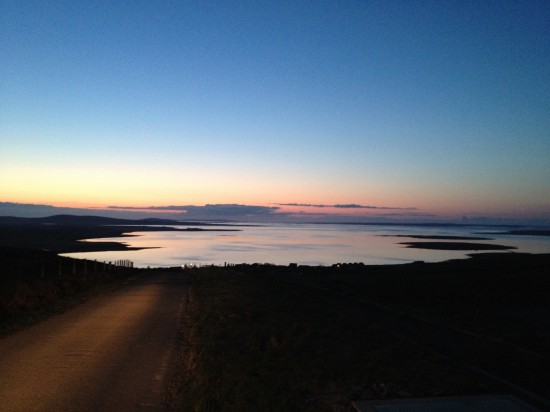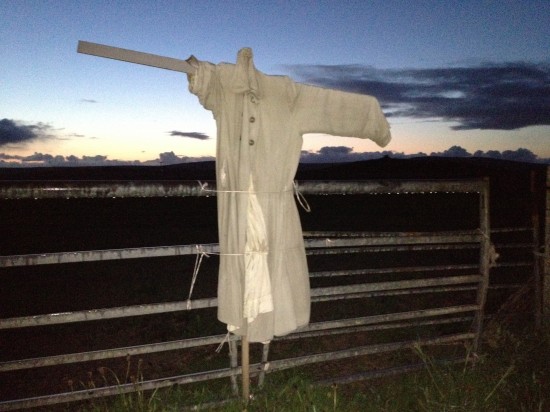
by Amy Liptrot
2am on Friday night and I’m alone down a farm track on a farflung island, dancing in my headlights, because I heard a medium-sized brown bird.
For the last few weeks, I’ve been a night listener, searching the islands of Orkney trying to hear the endangered corncrake. The corncrake (latin name crex crex, onomatopoeia of their distinctive rasping call) used to be common across the whole UK – their call the soundtrack to summer evenings. Numbers dramatically declined in the twentieth century, mainly due to intensive farming, and now they are only found on the western isles and Orkney in this country. By the end of the summer last year, just 31 calling males were located here.
My survey is carried out between midnight and 3am, by car. I stop every 250-500 metres, wind down the windows and listen for two minutes. Over seven weeks, I have to survey every 1km map grid square in Orkney containing suitable corncrake habitat (hay and silage fields, tall vegetation such as nettles or iris) – twice. After the other people in my house have gone to bed, sometime after 11pm, I fill my coffee thermos, put on my fleece-lined trousers, make sure I have my maps and phone charged and drive out into the countryside.

At this time of year in Orkney – the weeks around midsummer – it barely gets dark overnight, the sky just dims. This time between sunrise and sunset is known as the ‘gloaming’, ‘simmer dim’ or the ‘grimlins’, from the Old Norse word grimla, which means to twinkle or glimmer. I feel like the only person awake on the island, and am usually the only car on the road. I imagine I’m the lone survivor – just me and the birds.
I am lucky to have an excuse to stop and listen. It takes a few seconds for the car’s engine to stop running and quieten, then for your personal velocity to come to a halt, heartbeat to slow, clothes stop russling – for the noise in your head to fall away and the sounds of nature to reveal themselves. I become dark adjusted and alert to noise: Chin on the open window, cool wind on my face, occasionally catching my reflection in the wing mirror, with my ears held forward by my woolly hat into prime listening position. Two minutes can seem a long time when you’re concentrating.
Even at 1am – the darkest point of the night in British Summer Time – the birds are going bonkers. I hear the ‘classic three’ Orkney birds – curlew, oystercatcher, lapwing – nearly every time I stop. I note down unfamiliar calls to ask my knowledgeable colleagues back in the RSPB office: ‘creaking bedsprings’, ‘dial-up modem’, ‘haunted chicken’. They inform me that the ‘shivery, baby goat’ sound I hear is snipe, drumming – an eerie, memorable wobble made by its tail feathers. There are other noises too: of wind turbines, domestic animals and livestock, a flowing burn, the sea, wind and rain. I learn that, although I can’t see much on foggy nights, sound travels further in the mist.
The sun both rises and sets northish at this time of year, just dipping below the horizon, so surveying the north coast is particularly special. Speeding home, just getting light, the currents of Eynhallow Sound are churning through the mist. I get out and walk around the Ring of Brodgar at 2:45am with the grimlins and the moon shining off the loch. I park at the top of the hill with the TV and phone transmitters and look down at the lights of Kirkwall.
I can go for nights without hearing a corncrake. The weather gets into the car. On the rare occasions I see another car I wonder what are they doing on the hillside at this time of night and they think the same about me. Twice a farmer comes and asks me what I’m doing. At times I’m scared, down an unfamiliar country road alone at night, shocked by a scarecrow. Twitter has helped – I’m connected to the world through my phone, google maps helping me navigate in the dark. The survey can become monotonous, but when I’m flagging the sky does something amazing.
I’ve caught a goose, a hare and a teenager in my headlights. I caught the full moon in my wing mirror. I drove to the edge of the cliff, trying to get closer to the sky, looking out to smaller islands, with their lighthouses glowing, flashes of sunrise reflected on Scapa Flow. I share the night with cats – their eyes shining in the dykes – short-eared owls (plentiful this year and known locally as ‘catty faces’), voles and hedgehogs crossing the road.
I am in perpetual hope. I want to hear corncrakes at each stop and briefly mistake its call for the quack of a duck, the churning of the blades of a wind turbine, the rasping breathing of a cow. But although I have heard quite a few, I have not yet seen one yet. Corncrakes are extremely secretive birds, hiding low in the long grass. John Clare, in his poem The Land Rail, describes the phenomenon: “Tis like a fancy everywhere/A sort of living doubt”. I begin to doubt my belief in corncrakes. Maybe they are a collective hallucination?
In my confusion I don’t know where I am. What passing place is this? I can’t tell if this is dusk or dawn. It’s weird and beautiful out here and the moon is red. It got really misty and the mist has turned pink in the sunrise and I can hear seals howling like ghouls. Then I’m confused by the sight of a cruise ship – all lit up out to sea like a tower block floating in space.
But the light – by 3am I don’t need the car light to read – reveals where you have been all along. It’s just my familiar island. Surveying the West Mainland in particular, each road is full of memories. This is where, about once a week, the school bus got stuck behind a dairy herd, this is the corner where my brother was born. I’ve driven thousands of miles within a 50-mile-diameter island. I have driven all of Orkney’s roads and transversed its tracks, grooved its geography into my mind, its contour lines onto my skin, making it more difficult to leave like I want.
Click here to read Amy’s previous pieces for Caught by the River.